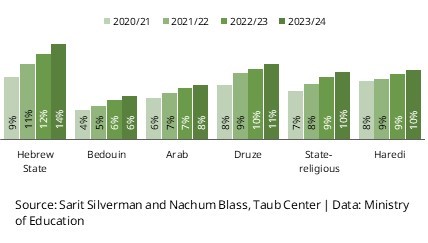The Taub Center releases groundbreaking new research on the special education crisis in Israeli preschools from the 2020/21 to 2023/24 school years. The findings reveal a dramatic surge in children receiving special education services, alongside stark disparities across educational streams and socioeconomic clusters. This study, conducted with the generous support of the Beracha Foundation, the van Leer Foundation, Yad Hanadiv, and the Shashua Family Foundation, is the first comprehensive study to focus specifically on preschool-age children — the most critical period for early intervention. Study authors Dr. Sarit Silverman and Nachum Blass identify specific areas demanding immediate policy reform.
Sharp rise in special education enrollment, while general education declines
The research reveals a striking increase in children receiving special education services during the study period — from approximately 42,000 in 2020/21 to approximately 57,000 in 2023/24. In just four years, the number of children receiving special education services jumped by 36%. This surge far outpaces overall population growth during the same period and occurs alongside a 3% decline in general education preschool enrollment (not including inclusion students). According to the researchers, this growth reflects not only demographic shifts but also systemic barriers in identifying and serving children with special needs.
Despite inclusion policies, most children with special needs still learn in separate settings
During the study period, inclusion of children with special needs in general education preschools through individualized support doubled. Nevertheless, the researchers emphasize, separate special education preschools remain the primary track, serving approximately 50% of children who receive special education services.
Systemic inequality: severe inequalities in special education participation across educational streams
The research findings show that 60% of children in separate special education preschools are in the Hebrew State system, compared to only 34% of general education students — a significant overrepresentation indicating disparities in access to these services across educational streams. In contrast, other streams are underrepresented and rely more heavily on institutional support — a trend that may stem from shortages of separate special education facilities, or limited access to diagnostic services.
Trends in special education preschool registration by sector and educational stream

Dramatic disadvantage in autism diagnosis and services
70% of students diagnosed with autism spectrum disorder and receiving special education services are in the Hebrew State system — predominantly from middle to high socioeconomic clusters, with minimal representation from disadvantaged areas. According to a recent Taub Center study on language developmental milestones, children from low socioeconomic backgrounds face significantly higher risk for language delays. The researchers point to a troubling “double disadvantage”: populations at highest risk for language and developmental delays are also those least represented in special education services.
Distribution of preschoolers by sector and educational stream
and disability type compared to general preschoolers, 2023/24




